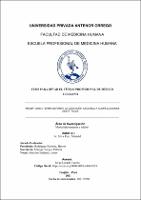| dc.contributor.advisor | Lozada Caceda, Jorge | |
| dc.contributor.author | Silva Ruiz, Medalid | |
| dc.creator | Silva Ruiz, Medalid | |
| dc.date.accessioned | 2021-09-20T16:01:19Z | |
| dc.date.available | 2021-09-20T16:01:19Z | |
| dc.date.issued | 2021 | |
| dc.identifier.uri | https://hdl.handle.net/20.500.12759/8011 | |
| dc.description.abstract | Determinar si existe asociación entre la miomatosis uterina
durante la gestación y complicaciones obstétricas.
Material y métodos: Se aplicó un estudio analítico, observacional de
cohorte retrospectivo, para lo cual se tomó una muestra que fue
constituida por 144 gestantes, atendidas en el Servicio de Obstetricia del
Hospital La Caleta en el período enero 2014- diciembre 2018, de las
cuales 72 gestantes formaron el grupo de cohorte expuesta y otras 72
gestantes la cohorte no expuesta.
- Resultados: En el periodo estudiado podemos observar que la
incidencia de complicaciones obstétricas en el grupo expuesto fue
31.90% y en el grupo no expuesto de 12.50%. Las complicaciones más
frecuentes en las gestantes con miomatosis uterina fueron placenta
previa y rotura prematura de membranas. El mayor porcentaje de
gestantes que presentaron miomatosis uterina se encontraban entre las
edades de 34 a 42 años. Las gestantes con miomatosis uterina tienen el
riesgo de 2.9 veces de tener complicaciones obstétricas, el cual fue
significativo estadísticamente.
- Conclusión: Si existe asociación entre la miomatosis uterina durante la
gestación y complicaciones obstétricas. | es_PE |
| dc.description.abstract | To determine if there is an association between uterine myomatosis
during pregnancy and obstetric complications.
Material and methods: An analytical, observational retrospective cohort study
was applied, for which a sample was taken that consisted of 144 pregnant
women, attended at the Obstetric Service of Hospital La Caleta in the period
January 2014 - December 2018, from the which 72 pregnant women formed the
exposed cohort group and another 72 pregnant women the unexposed cohort.
Results: In the studied period we can observe that the incidence of obstetric
complications in the exposed group was 31.90% and in the unexposed group it
was 12.50%. The most frequent complications in pregnant women with uterine
myomatosis were placenta previa and premature rupture of the membranes.
The highest percentage of pregnant women who presented uterine myomatosis
were between the ages of 34 to 42 years. Pregnant women with uterine
myomatosis have a 2.9-fold risk of obstetric complications, which was
statistically significant.
- Conclusion: If there is an association between uterine myomatosis during
pregnancy and obstetric complications. | en_US |
| dc.description.uri | Tesis | es_PE |
| dc.format | application/pdf | es_PE |
| dc.language.iso | spa | es_PE |
| dc.publisher | Universidad Privada Antenor Orrego | es_PE |
| dc.relation.ispartofseries | T_MED_3089 | |
| dc.rights | info:eu-repo/semantics/openAccess | es_PE |
| dc.rights.uri | https://creativecommons.org/licenses/by/4.0/ | es_PE |
| dc.source | Universidad Privada Antenor Orrego | es_PE |
| dc.source | Repositorio institucional - UPAO | es_PE |
| dc.subject | Miomas Uterinos | es_PE |
| dc.subject | Complicaciones Obstétricas | es_PE |
| dc.title | Miomatosis uterina durante la gestación asociada a complicaciones obstétricas | es_PE |
| dc.type | info:eu-repo/semantics/bachelorThesis | es_PE |
| thesis.degree.grantor | Universidad Privada Antenor Orrego. Facultad de Medicina Humana | es_PE |
| thesis.degree.name | Medico Cirujano | es_PE |
| thesis.degree.discipline | Medicina | es_PE |
| dc.subject.ocde | http://purl.org/pe-repo/ocde/ford#3.02.27 | es_PE |
| renati.advisor.orcid | https://orcid.org/0000-0002-4404-924X | es_PE |
| renati.author.dni | 76968206 | |
| renati.advisor.dni | 18828960 | |
| renati.type | http://purl.org/pe-repo/renati/type#tesis | es_PE |
| renati.level | http://purl.org/pe-repo/renati/level#tituloProfesional | es_PE |
| renati.discipline | 912016 | es_PE |
| renati.juror | Rodríguez Barboza, Héctor | |
| renati.juror | Urteaga Vargas, Patricia | |
| renati.juror | Alarcón Gutiérrez, Javier | |
| dc.publisher.country | PE | es_PE |


